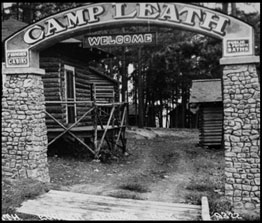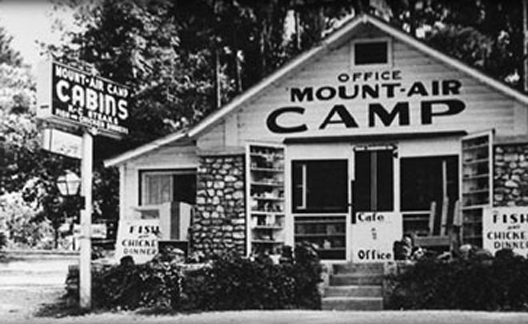The Auto Age in Eureka Springs
by Glenna Booth
In the not-so-distant past, our predecessors in the preservation movement fought to protect remnants of the Victorian age — buildings and neighborhoods considered old and ugly in the modern 1950s and '60s couldn’t be put in the dumpster fast enough. While these resources continue to be at risk, there is at least a body of knowledge about their significance, history and care. However, now preservationists are confronting an even greater challenge – how to deal with 20th century buildings.
This era is called “The Recent Past.” It has been described as “history you can pick out in your own life in your own town.” The venerable National Park Service National Register of Historic Places considers a property eligible for listing when it is 50 years old. For now, that date is 1958. It is hard to think of something as historic when we remember when it was built!
This is especially the case with the roadside commercial development that evolved with our love of the automobile. These structures have entered that endangered period when they are just “old and ugly,” much like the status of Victorian-era buildings in the '50s and '60s. In most places urban sprawl has erased whole categories of these once-everywhere roadside essentials. When did you last see a filling station with garage? Motor court? Diner? Tower with a view?
The highways, when you can exit them, all have the same chain motels, restaurants, convenience store/gas stations — all carefully designed so that there are no surprises for the traveler. Today, Eureka Springs is fortunate to be one of the few places in Arkansas, maybe even America, which still has the mid-century roadside culture intact to tell this part of our history: The Auto Age. These motor courts, restaurants, gas stations and attractions are as much a part of the history of Eureka Springs (and the United States) as the earlier downtown buildings.
Our still-intact collection of roadside culture is just as rare as the downtown turn-of-the century collection of architecture. Eureka Springs, Arkansas, was founded in 1879 as a spa town. As a boom town, it came to life as word of the benefits of healing springs located within the area spread. In the 1890s the town blossomed into an elegant resort. Health-seekers both rich and poor came via stagecoach, wagon, horseback, on foot and railway “to take the waters.” This “spa era” continued until around 1910, when modern medical practices changed the ways in which illnesses were treated and the automobile changed the way in which people traveled.
The heart of Eureka Springs is a two-square mile area in which about 700 structures cling to hillsides held up by 55 miles of retaining walls. Sitting virtually undisturbed for decades, Eureka Springs is now noted for its eclectic mix of turn-of-the-century architecture. In 1970, the entire town was placed on the National Register of Historic Places and re-listed in 2005 as “Nationally Significant.” Outside of downtown, Eureka Springs is edged by US Highway 62, a major artery running from Niagara Falls, New York, to El Paso, Texas.
Built in the ’30s, this highway is still a major thoroughfare across the nation. Early in the Auto Age, Eureka Springs benefited from a very savvy politician, Claude A. Fuller, who worked in in various leadership roles. As mayor, he had five miles of streets paved in concrete — taking advantage of a new state law that permitted the state highway department to build highways through towns providing the towns pay half the cost. He later found a way for the town’s share to be forgiven.
From 1928 to 1938 he served in the House of Representatives and was influential in routing US Highway 62 through the rocky Ozark Mountains near Eureka Springs. It was Fuller, through connections made earlier during his time in the Arkansas legislature, who arranged for the prison camp and labor in the early 1920s who hand-picked the road from limestone bluffs that would later become US Highway 62 – Route 62.
When first completed, this part of US Highway 62 was known as The Ozark Skyway or the Ozark Trail. Its history followed the pattern of many early roads. At the start of the twentieth century, good roads were not a necessity and automobiles were a novelty used only by the very rich.
Continued above right...
plate 1. The Mount Air Camp Office. Courtesy of Glenna Booth.

plate 2. The tourist camp known as Camp Leath. Photo courtesy of Glenna Booth
Most rural Americans traveled by foot, horse or horse and buggy.Urban dwellers used networks of subways and streetcars. Out-of-town trips were made via the extensive rail service that reached out into all areas of the United States, both urban and rural.
Henry Ford’s affordable Model T changed all this. In 1912, there were an estimated 12 cross-country drivers; 10 years later there were an estimated 10.8 million cars on the roads. The increase in the number of cars led to the demand for good roads and travel amenities.
Most early auto roads were based on the old wagon trails and even later major highways are vestiges of these. Local and national organizations formed to promote better roads, then name and mark them.
By 1925 there were over 250 named highways (each with their own randomly placed signs). The 1916 Federal Aid Highway Act was a response to this confusion.
The ’20s and ’30s were the “golden age” of road building. The government organized these private- and community-owned roads into a system of numbered highways, which included Highway 62. The earliest cross-country drivers considered themselves modern gypsies, “Thoreau on 29 cents a gallon,” stopping and camping by the road, in a field, where they fancied. This might have been fine for a few travelers, but not for large numbers.
Municipalities offered free campgrounds in an effort to get these travelers out farmers’ fields and into downtown. However, this proved too expensive and towns began charging fees. This gave entrepreneurs a chance to appeal to this traveler and began the evolution of roadside travel accommodations.
By the late thirties, US Highway 62 was a major transcontinental highway running right by Eureka Springs. Travelers stopped to visit the curious little town or chose it as a resting place before continuing on the region’s tortuous roads.
On the Route 62 edge of Eureka Springs, the auto traveler was king! As needs and desires of this traveler changed, so did the accommodations specially designed for automobiles.
The site of the 2008 Arkansas Historical Association Conference is probably one of the few places that embodies the full evolution of roadside accommodations.
Beginning as Tower Heights Park Campground in the early 1920s, the business boasted “a handsome large pavilion, concrete floored, well screened, supplied with handy, pure water, kitchen equipment, tables, seats, refrigerators, and a pleasant, cool place for cooking and eating.”
Following campgrounds, the next era of lodging was the auto camp, with basic cabins and the same central pavilion and shared bathhouse.
Tower Heights became Camp Leath (pictured below), with rustic log cabins in the pines and the same central amenities. Following the national trends, more amenities were added to the cabins and the name changed to Mount Air Camp (see photo above).
Next the cabins became cottages with private baths instead of the central building and the name was modernized to Mount Air Cottages, then modernized again to Mount Air Court.
The Mount Air Café provided an easy substitute for kitchenettes and offered fried chicken and huckleberry pie from early on, changing to the Country Kitchen in 1972 then Myrtie Mae’s in 1992.
In the 1960s, the little cottages were replaced with an "ultra-modern" motel, (combination of motor court and hotel) with all units in one streamlined block and free TVs in the rooms.
Horseshoes were replaced with a heated swimming pool.
In the 1970s, the owners joined the Best Western lodging franchise and, combining the past with the present, became the Best Western Mount Air Lodge Inn of the Ozarks. When the convention center was added in 1977, it settled on Best Western Inn of the Ozarks Resort and Convention Center. Although Mount Air Lodge and Restaurant is still in the phone book.
More units were added as well as tennis courts and a game room. In the back, adjacent to the pool, is a “pleasant, cool place for … eating” pavilion – coming full circle from campground days!
As the railroads changed the fabric of American life, so did the automobile. Eureka Springs offers a unique opportunity to experience both eras. And while not as famous as Route 66, Route 62 still has an important place in both local and highway history.
“… I’ll see you on Route 62!”
— Glenna Booth, Arkansas Community of Excellence coordinator for the City of Eureka Springs
March 27, 2008




